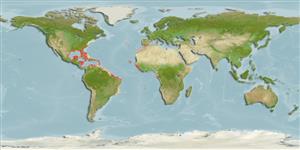>
Tetraodontiformes (Puffers and filefishes) >
Monacanthidae (Filefishes)
Etymology: Cantherhines: Greek, kanthos = the outer or inner corner of the eye, where the lids meet, 1646 + Greek, rhinos = nose (Ref. 45335).
Environment: milieu / climate zone / depth range / distribution range
البيئة
بحري مرتبطة بالشعاب; نطاق العمق 3 - 50 m (Ref. 3592), usually 3 - 20 m (Ref. 40849). Subtropical; 42°N - 26°S, 98°W - 10°E
Western Atlantic: Massachusetts (USA), Bermuda, and northern Gulf of Mexico to southeastern Brazil. Eastern Atlantic: São Tomé, Gulf of Guinea (Ref. 3592).
الحجم / وزن / العمر
Maturity: Lm ? range ? - ? cm
Max length : 20.0 cm TL ذكر/ مختلط الجنس; (Ref. 7251); common length : 14.0 cm TL ذكر/ مختلط الجنس; (Ref. 3592)
الأشواك الظهرية (المجموع): 2; الأشعة الظهرية الناعمة (المجموع): 33-36; شوكة شرجية 0; أشعه شرجية لينه: 29 - 32. First dorsal spine originating over center or front part of eye and followed by a deep groove into which the spine can fold; body with small scattered orange spots, many of which have brown centers, and whitish spots of same size; dull yellow lines on head which run towards snout, those near eye alternating with bluish lines (Ref. 13442).
Found in shallow water and around coral and rocky reefs (Ref. 3790). Usually remains near the bottom, hiding among gorgonians and branching coral (Ref. 9710). Feeds on bottom growth, primarily sponge and algae, but stomach often contain tunicates, bryozoans and other sessile benthic invertebrates (Ref. 5521). The young are pelagic and highly important food items in the diet of large predaceous fishes such as tunas and billfishes (Ref. 3790). Generally considered as trash fish, rarely consumed (Ref. 3790).
Life cycle and mating behavior
النضج | التكاثر | وضع البيض | بيض | الخصوبة | Larvae
Robins, C.R. and G.C. Ray, 1986. A field guide to Atlantic coast fishes of North America. Houghton Mifflin Company, Boston, U.S.A. 354 p. (Ref. 7251)
IUCN Red List Status (Ref. 130435)
Warning: mysqli::__construct(): (08004/1040): Too many connections in /var/www/html/includes/func_getlabel.php on line 46
Can't connect to MySQL database (fbapp). Errorcode: Too many connections
